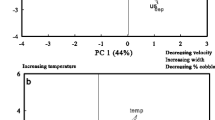Abstract
There is an exceptionally rich aquatic fauna in the epikarst, the skin of karst. High species richness in the epikarst, coupled with its special vulnerability as the first point of entry of nearly all toxic spills, makes its protection especially important. The epikarst fauna may also be an useful tool in tracing the potential route of pollutants. Copepods in epikarst have extremely local distributions, and their body size is such that they are largely at the mercy of directional flows. In a series of caves in southwest Slovenia and West Virginia, a significant fraction of the copepod species occur in less than 100 m of linear extent. This suggests a pattern of highly restricted lateral flow under normal conditions and the distribution of copepods could potentially be used to trace water movement. Under high flow conditions as would often be the case with toxic spill, mounding of water may increase the lateral radius of flow. Nevertheless, copepods may be useful tracers.


Similar content being viewed by others
References
Bakalowicz M (2004) The epikarst, the skin of karst. In: Epikarst. In: Jones WK, Culver, DC, Herman JS (eds) Proceedings of the symposium held October 1 through 4, 2003, Shepherdstown, West Virginia, USA, Karst Waters Institute, Charles Town, pp 16–22
Gabrovšek F (2004) Attempts to model the early evolution of epikarst. In: Jones WK, Culver DC, Herman JS (eds) Epikarst. Proceedings of the symposium held October 1 through 4, 2003, Shepherdstown, West Virginia, USA, Karst Waters Institute, Charles Town, pp 50–55
Gordon ND, McMahon TA, Finlayson BL (1999) Stream hydrology: an introduction for ecologists. Wiley, Chichester, 511 pp
Huys R, Boxshall GA (1991) Copepod evolution. The Ray Society, London, 468 pp
Jones WK, Culver DC, Herman JS (eds) (2004) Epikarst. In: Proceedings of the symposium held October 1 through 4, 2003, Shepherdstown, West Virginia, USA, Karst Waters Institute, Charles Town, 160 pp
Kogovšek J, Šebela S (2004) Water tracing through the vadose zone above Postojnska jama, Slovenia. Env Geol 45:992–1001
Pesce GL, Galassi DP (1986) Taxonomic and phylogenetic value of the armature of coax and antenna in stygobiont cyclopoid copepods. Bull Zool Suppl 53:58–72
Pipan T (2005) Epikarst—a promising habitat. Copepod fauna, its diversity and ecology: a case study from Slovenia (Europe). Založba ZRC, Inštitut za raziskovanje krasa ZRC SAZU, Postojna, 101 pp
Pipan T, Brancelj A (2004) Distribution patterns of copepods (Crustacea: Copepoda) in percolation water of the Postojnska Jama cave system, Slovenia. Zool Stud 43:206–210
Pipan T, Christman MC, Culver DC (2006) Dynamics of epikarstic communities: microgeographic pattern and environmental determinants of epikarstic copepods in Organ Cave, West Virginia. Am Midland Nat 156(1):75–87
Pipan T, Culver DC (2005) Estimating biodiversity in the epikarstic zone of a West Virginia cave. J Cave and Karst Stud 67:103–109
Sket B, Trontelj P, Žagar C (2004) Speleobiological characterization of the epikarst and its hydrological neighborhood: its role in dispersion of biota, its ecology and vulnerability. In: Jones WK, Culver DC and Herman JS (eds) Epikarst. Proceedings of the symposium held October 1 through 4, 2003, Shepherdstown, West Virginia, USA, Karst Waters Institute, Charles Town, pp 104–113
Smart PL, Friederich H (1987) Water movement and storage in the unsaturated zone of maturely karstified carbonate aquifer, Mendip Hills, England. In: Proceedings of conference on environmental problems in Karst Terranes and their solutions, National Water Well Association, Dublin, USA, pp 59–87
Smith IR (1975) Turbulence in lakes and rivers. Special Publication 29, Fresh Water Biological Association, UK
Stoch F (1995) The ecological and historical determinants of crustacean diversity in groundwaters, or why are there so many species? Mém Biospéol 22:139–160
Trček B (2003) Epikarst zone and the karst aquifer behavior. A case study of the Hubelj Catchment, Slovenia. Geološki zavod Slovenije Ljubljana, 100 pp
Acknowledgments
Field research in West Virginia was supported by funds from the Center for Subterranean Biodiversity of the Karst Waters Institute and Cave Conservancy Foundation. Additional support came from Ministrstvo za visoko šolstvo, znanost in tehnologijo Republike Slovenije.
Author information
Authors and Affiliations
Corresponding author
Rights and permissions
About this article
Cite this article
Pipan, T., Culver, D.C. Epikarst communities: biodiversity hotspots and potential water tracers. Environ Geol 53, 265–269 (2007). https://doi.org/10.1007/s00254-007-0640-y
Received:
Accepted:
Published:
Issue Date:
DOI: https://doi.org/10.1007/s00254-007-0640-y




